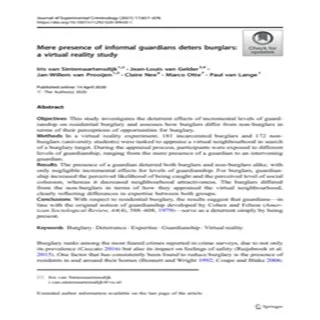By Iris van Sintemaartensdijk & Jean-Louis van Gelder & Jan-Willem van Prooijen & Claire Nee & Marco Otte & Paul van Lange
Objectives This study investigates the deterrent effects of incremental levels of guardianship on residential burglary and assesses how burglars differ from non-burglars in terms of their perceptions of opportunities for burglary. Methods In a virtual reality experiment, 181 incarcerated burglars and 172 nonburglars (university students) were tasked to appraise a virtual neighbourhood in search of a burglary target. During the appraisal process, participants were exposed to different levels of guardianship, ranging from the mere presence of a guardian to an intervening guardian. Results The presence of a guardian deterred both burglars and non-burglars alike, with only negligible incremental effects for levels of guardianship. For burglars, guardianship increased the perceived likelihood of being caught and the perceived level of social cohesion, whereas it decreased neighbourhood attractiveness. The burglars differed from the non-burglars in terms of how they appraised the virtual neighbourhood, clearly reflecting differences in expertise between both groups. Conclusions With respect to residential burglary, the results suggest that guardians—in line with the original notion of guardianship developed by Cohen and Felson (American Sociological Review, 44(4), 588–608, 1979)—serve as a deterrent simply by being present.
Journal of Experimental Criminology (2021) 17:657–676


















